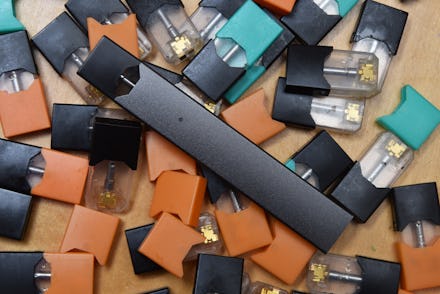Will Trump's ban of popular vape flavors actually keep e-cigarettes away from young people?

On January 2, the Trump administration revealed plans to ban vape cartridges of all flavors — except tobacco and menthol — from the market by early February. Indeed, flavored vapes, many of which taste like candy, have been blamed for getting youth hooked, and vaping-related lung illness continues to sicken people across the US. But will the administration’s partial vape ban actually curb youth vaping, or the vaping-related lung illness outbreak?
Natasha Bhuyan, a family physician in Phoenix, tells Mic that she sees the policy as a step in the right direction, but doesn’t believe it goes far enough to address either problem, since it would still leave broad categories of vaping devices available to consumers.
For starters, the policy wouldn’t include menthol-flavored cartridges, which Bhuyan thinks would still attract youth, an estimated 5.3 million of whom vape, according to a recent Journal of the American Medical Association study. Menthol tastes a lot like mint, which another JAMA study found to be the most popular flavor among high schoolers. Bhuyan worries that, by giving the green light to menthol, the policy might spur companies to simply label their mint-flavored cartridges as menthol-flavored.
Another point to consider is that flavor isn’t the only draw for youth. For instance, Bhuyan says many of her teen patients are into cloud chasing, or blowing huge vapor plumes, which the policy doesn’t remedy. “This ban doesn’t address all the things that teens are attracted to when vaping,” she says.
Besides a more sweeping ban, there does need to be a lot more education done for the public, so we can help people understand the dangers of vaping.
Vapes with refillable tanks — which allow consumers to mix their own vape juice, in contrast to cartridges, which are pre-filled, the Wall Street Journal explains — would also be exempt from the policy, leaving them open as an easily accessible alternative once most flavored cartridges are removed from the market. Indeed, Bhuyan notes that tank-based vapes are readily available in vape shops, and they account for 40% of the US vaping market, according to the Wall Street Journal.
Although the WSJ notes that tank-based vapes aren’t as popular among youth as cartridge-based vapes, there doesn’t seem to be much stopping them from switching over. “Kids can easily look up on YouTube how to open [vape tanks] and refill them,” Erika Sward, a spokesperson for the American Lung Association, tells Mic.
Bhuyan adds that the administration’s policy would also have little impact on the outbreak of vaping-related lung injury, which has resulted in 2,561 hospitalizations and 55 deaths as of December 27, per the Centers for Disease Control. These cases are often related to thickening agents in illegal cartridges that contain tetrahydrocannabinol, or THC, the compound in cannabis that gets you high, which the policy doesn’t address either, Bhuyan says.
She would’ve preferred the proposal the Trump was considering in September to ban all flavored vapes, without exempting menthol cartridges or tank-based devices, and notes that in leaving some options available, the administration seemed to be attempting to balance the youth vaping epidemic with the needs of adults trying to use vapes to quit regular cigarettes.
The CDC notes that nicotine-containing vapes may help wean some adult smokers off cigarettes, and vaping advocates often credit the practice for allowing them to quit smoking — but in reality, many end up simply switching to vapes without ever transitioning out of them, Bhuyan says.
Indeed, a statement from White House counselor Kellyanne Conway said that the administration’s ban “balances the protection of children’s health and the protection of adults rights,” the New York Times reports. The outlet also noted that vaping industry lobbyists, conservative groups, and some of Trump’s advisers fought against a complete ban on flavored vapes.
Besides a more sweeping ban, “there does need to be a lot more education done for the public, so we can help people understand the dangers of vaping,” Bhuyan says. In addition to acute lung-related illness, a recent study suggests that vaping increases the risk of chronic lung disease, which a ban on only certain vape devices likely wouldn’t address. Overall, a partial ban on flavored vapes may just be a band-aid at best.